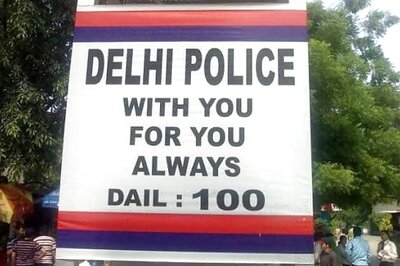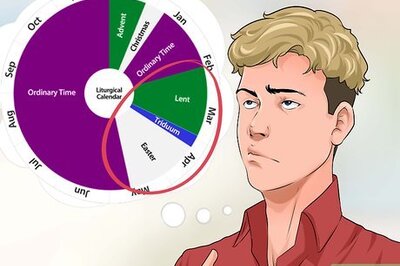
views
Call it the honeybee effect, but the "sting" seems to have well and truly arrived in Indian journalism. What started off as some form of "parallel" journalism when Anirudh Bahal and co first used the hidden camera to expose match-fixing and defence deals has now become "mainstream". In fact, when the Tehelka story first broke, most journalists were dismissive of the hidden camera. At best, it was seen as "intrusive", at worst, downright unethical. Questions were raised over whether ends could ever justify the means, whether the "noble" traditions of journalism were being subverted by the use of the hidden camera, and whether the manner in which the investigations were carried out amounted to little more than "entrapment". Four years after the Tehelka story broke, those questions are no longer asked with the same vigour. In fact, in most instances, we don't ask them at all. The "parallel" has become "mainstream".
Just look at the increasing number of spycam investigations that are now proliferating across television screens. If we at CNN-IBN do a hidden camera investigation exposing corruption among UP politicians, another channel responds by using a hidden camera to show how impurities exist in milk.
Much of what is happening is laudable, if the effect is to force a notoriously opaque society to become more transparent and accountable. I have said this in the past -- and I will say it again -- a spycam investigation is justified if the "public interest" which is being served is of such an overwhelming nature that it demands the use of such methods. Moreover, as technology becomes easier to handle, there is no reason why journalists should not use it as part of their armoury.
However, watching some of the channels resorting to the hidden camera now, I fear that the spycam is now less about "investigation", and more about "effect". Somehow what is legitimate technology is becoming an end in itself. The story matters less than the technique used.
Through blurred images and sinister voices, the attempt is being made to "create" a story where it is just possible that the same story could have been done without using the spycam. No context, no cross-checking, little follow-up, the story often fails to apply the basic principles of good journalism. Its almost as if the journalist feels that the only way to create an "impact" in a cluttered news market is to show off the hidden camera. The good old-fashioned "overground" story is almost becoming redundant, which is why I believe that the recent half hour episode we did on the Maoists in Chatisgarh was a refreshing departure from what has otherwise become the norm.
What is really needed is a system of regulation for use of the hidden camera. The United States has gone to one extreme, where by law only the state agencies are allowed to use the spycam. In all other instances, the use of the spycam is seen as a case of "entrapment", punishable by law. British broadcasters and the tabloid media (with the notable exception of the BBC) by contrast have been far more liberal in allowing journalists to use the hidden camera, although there are clear guidelines in place on the use of such devices.
In India, we have neither any laws or basic rules in place for spycam investigations. No, we don't want our parliamentarians framing laws for us as is being attempted-- history suggests that any such attempt is fraught with the risk of state intervention. Nor do we want to stop using the hidden camera. What we do need though is some form of self-regulation or, better still, a code of ethics for broadcasters, framed and followed by the industry. In the absence of such a regulatory code, its open season for the sting.
About the AuthorRajdeep Sardesai Rajdeep Sardesai was the Editor-in-Chief, IBN18 Network, that includes CNN-IBN, IBN 7 and IBN Lokmat. He has covered some of the biggest stories in I...Read Morefirst published:March 20, 2006, 11:13 ISTlast updated:March 20, 2006, 11:13 IST
window._taboola = window._taboola || [];_taboola.push({mode: 'thumbnails-mid-article',container: 'taboola-mid-article-thumbnails',placement: 'Mid Article Thumbnails',target_type: 'mix'});
let eventFire = false;
window.addEventListener('scroll', () => {
if (window.taboolaInt && !eventFire) {
setTimeout(() => {
ga('send', 'event', 'Mid Article Thumbnails', 'PV');
ga('set', 'dimension22', "Taboola Yes");
}, 4000);
eventFire = true;
}
});
window._taboola = window._taboola || [];_taboola.push({mode: 'thumbnails-a', container: 'taboola-below-article-thumbnails', placement: 'Below Article Thumbnails', target_type: 'mix' });Latest News
In my new avatar, most people who call or sms me to wish a happy holi are usually job-seekers. A few days ago, a young aspiring journalist rang up to ask me if he could be accomodated in CNN-IBN. What would he like to do, I asked. Pat came the answer: "Sir, I would like to focus on sting operations!"
Call it the honeybee effect, but the "sting" seems to have well and truly arrived in Indian journalism. What started off as some form of "parallel" journalism when Anirudh Bahal and co first used the hidden camera to expose match-fixing and defence deals has now become "mainstream". In fact, when the Tehelka story first broke, most journalists were dismissive of the hidden camera. At best, it was seen as "intrusive", at worst, downright unethical. Questions were raised over whether ends could ever justify the means, whether the "noble" traditions of journalism were being subverted by the use of the hidden camera, and whether the manner in which the investigations were carried out amounted to little more than "entrapment". Four years after the Tehelka story broke, those questions are no longer asked with the same vigour. In fact, in most instances, we don't ask them at all. The "parallel" has become "mainstream".
Just look at the increasing number of spycam investigations that are now proliferating across television screens. If we at CNN-IBN do a hidden camera investigation exposing corruption among UP politicians, another channel responds by using a hidden camera to show how impurities exist in milk.
Much of what is happening is laudable, if the effect is to force a notoriously opaque society to become more transparent and accountable. I have said this in the past -- and I will say it again -- a spycam investigation is justified if the "public interest" which is being served is of such an overwhelming nature that it demands the use of such methods. Moreover, as technology becomes easier to handle, there is no reason why journalists should not use it as part of their armoury.
However, watching some of the channels resorting to the hidden camera now, I fear that the spycam is now less about "investigation", and more about "effect". Somehow what is legitimate technology is becoming an end in itself. The story matters less than the technique used.
Through blurred images and sinister voices, the attempt is being made to "create" a story where it is just possible that the same story could have been done without using the spycam. No context, no cross-checking, little follow-up, the story often fails to apply the basic principles of good journalism. Its almost as if the journalist feels that the only way to create an "impact" in a cluttered news market is to show off the hidden camera. The good old-fashioned "overground" story is almost becoming redundant, which is why I believe that the recent half hour episode we did on the Maoists in Chatisgarh was a refreshing departure from what has otherwise become the norm.
What is really needed is a system of regulation for use of the hidden camera. The United States has gone to one extreme, where by law only the state agencies are allowed to use the spycam. In all other instances, the use of the spycam is seen as a case of "entrapment", punishable by law. British broadcasters and the tabloid media (with the notable exception of the BBC) by contrast have been far more liberal in allowing journalists to use the hidden camera, although there are clear guidelines in place on the use of such devices.
In India, we have neither any laws or basic rules in place for spycam investigations. No, we don't want our parliamentarians framing laws for us as is being attempted-- history suggests that any such attempt is fraught with the risk of state intervention. Nor do we want to stop using the hidden camera. What we do need though is some form of self-regulation or, better still, a code of ethics for broadcasters, framed and followed by the industry. In the absence of such a regulatory code, its open season for the sting.
















Comments
0 comment